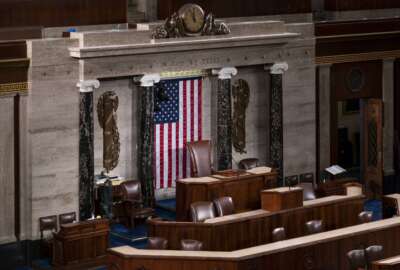DoD personnel miss out on absentee ballots
A Pentagon report found that more than a quarter of active-duty military personnel who requested absentee ballots for the 2010 election never received them. DoD...
wfedstaff | June 4, 2015 1:13 pm
A Defense Department report has found more than a quarter of military voters who requested absentee ballots for the 2010 election never got them. DoD is trying to figure out why and what to do about it.
The findings cover what was an otherwise upbeat year for military voting statistics: Uniformed voter participation was up 21 percent in 2010, compared with the last midterm election in 2006. And while voter registration rates among the general population tend to experience a noticeable drop-off between presidential election years and midterm cycles, DoD’s figures were relatively stable between 2008 and 2010.
But based on post-election surveys, the number of troops who requested military absentee ballots but never got them increased dramatically. The Pentagon’s Federal Voter Assistance Program (FVAP) estimates 29 percent of active duty military voters — roughly 120,000 troops — never got their ballots.
FVAP’s report offers one possible reason for that: 44 percent of local election officials missed the federal deadline, which requires them to send out military absentee ballots at least 45 days prior to election day. 
Carey said DoD doesn’t yet know if the problems were concentrated in particular areas. In the previous election cycle, however, New York City and southern Illinois seemed to be the worst offenders, he said.
But he hesitated to blame local elections officials. Military members themselves can be partially responsible for not getting their ballot in time: If an elections administrator doesn’t even receive a servicemember’s request for a ballot until after the 45 day deadline has lapsed, that deadline obviously can’t be met.
One potential fix
One potentially promising solution is to make the process electronic. A near term solution involves a one-way form of online voting. Some military members can download and print their ballots wherever they’re deployed and return them by mail, eliminating half of the delay that occurs in the current mail-based transit of ballots between elections offices and overseas servicemembers.
Carey said DoD learned a lot about that process in the 2010 cycle — namely, it’s a great idea, but it’s better left to the states to run it.
“In 2010, the Department of Defense funded a program for 17 states. But 14 more states did their own,” he said. “One of the things we found was that the states that did their own systems actually had much higher utilization than the ones that used our system. Our system was federally procured, so it was our decision as to who the vendor was going to be. We basically told all these states to attach our vendor to their own preexisting election systems. The states that did their own systems were able to integrate it and make it work. That’s why we’re going to a grant system for 2012 rather than a procurement system, so the states can build upon what they already have in place. These are big boys and girls. They’ve been elections officials for a long time.”
The next logical step is to move to full-scale electronic voting for active duty servicemembers, which could happen by 2016 or 2018, Carey said. At least one state, West Virginia, implemented online military voting in 2010. Arizona implemented a system that year that let deployed military voters upload and send images of their paper ballots to elections officials.
Giving e-voting a try
Carey said he expects several states to try various forms of e-voting for military members in next year’s election.
“There are inherent security risks with that, but there are inherent security risks with the current system, such as 120,000 people who think they’re getting a ballot don’t end up getting it. That’s a risk,” he said. “We’ve got to figure out whether we’re going to develop a federal system or whether we’re going to support the states in developing their own systems. And then we’ve also got to know what, exactly, the security, privacy and reliability requirements are to make the system workable.”
DoD is looking at what states have already done with e-voting as it tries to decide whether a federal solution makes sense, Carey said. As part of that effort, DoD has assigned its own cyber pros to try to hack into some of the existing online voting software to test its security. FVAP plans to announce the results soon, he added.
But, he said, his inclination is to let states lead, and that there are reasons to be concerned about setting up a single, centralized voting federal system run by the Pentagon.
“For the bad guys, even if they don’t hack into the system and change votes, just defacing the website would be a strategic victory for them. Especially if it’s a DoD system,” he said.
RELATED STORIES:
D.C. military e-voting faces roadblocks
This story is part of Federal News Radio’s daily DoD Report. For more defense news, click here.
Copyright © 2024 Federal News Network. All rights reserved. This website is not intended for users located within the European Economic Area.
Jared Serbu is deputy editor of Federal News Network and reports on the Defense Department’s contracting, legislative, workforce and IT issues.
Follow @jserbuWFED






